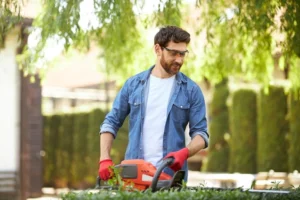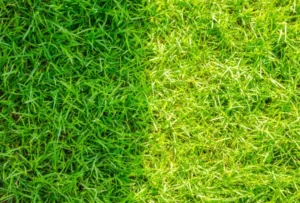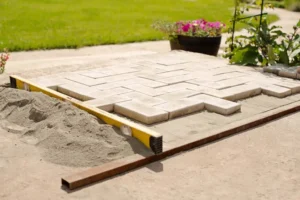What is the best infill for artificial turf is a key consideration when installing a synthetic lawn. Artificial grass infill, also called infill for turf, plays an important role in keeping the blades upright, adding cushioning, and improving drainage. Choosing the right option ensures your turf looks natural, feels comfortable, and lasts longer. In this guide, we’ll explain why infill is needed, explore the different types available, and help you decide which option is right for your project.
What is Artificial Turf Infill?
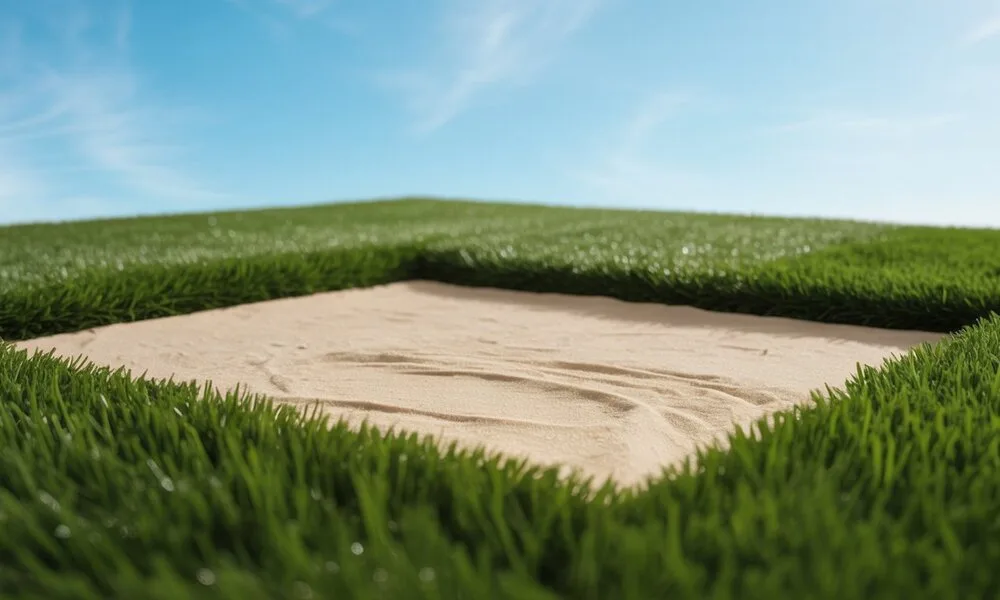
The material that goes between the blades of synthetic grass to make it heavier, more stable, and longer-lasting is called artificial turf infill. The grass would look flat and wear out rapidly without it. The infill for fake grass keeps the blades standing up straight, which makes the lawn look more natural and easier to walk on.
How turf infill works
When installed, fake grass infill settles between the blades of turf and fills the space at the base. This provides support, cushioning, and protection for the turf backing. It also helps distribute weight evenly, preventing matting and ensuring the turf stays in place even with heavy foot traffic.
Common materials used in infill
There are many types of infill for fake grass, and each has its own pros and cons. Silica sand, crumb rubber, coated sand, and organic materials like cork or walnut shells are the most prevalent forms. These materials provide different levels of cushioning, drainage, and cooling to suit residential and commercial turf applications.
Why Is Infill Needed For Turf?
Infill plays a critical role in maintaining both the performance and appearance of artificial lawns. Synthetic turf infill isn’t just an extra step—it’s what makes turf durable, safe, and natural-looking. Without infill for turf, the grass blades would quickly flatten, the surface would feel hard, and drainage would be less effective.
Cushioning and shock absorption
Synthetic turf infill makes the surface softer and more comfortable by absorbing impact. This cushioning reduces stress on joints, making the turf safer for activities like running, playing, or exercising.
Keeps turf blades upright
One of the main benefits of infill for turf is how it supports each blade. The material sits at the base, keeping the blades standing tall, which gives the lawn a realistic, lush appearance.
Improves longevity and drainage
By weighing the turf down, synthetic turf infill prevents shifting and wear. It also helps water drain properly through the turf backing, reducing puddles and keeping the surface usable year-round.
Safety for pets and children
Infill for turf enhances safety by creating a stable, cushioned surface. Whether it’s pets running across the lawn or kids playing, the infill reduces the risk of slips, falls, and hard impacts.
You may read How to Install Artificial Grass on Concrete?
What Types Of Turf Infill Options Are Available?
When choosing synthetic turf infill, it’s important to understand the different options available and their specific benefits. The right infill for turf depends on whether it’s for residential lawns, sports fields, or pet-friendly spaces.
Silica sand
Silica sand is one of the most cost-effective and widely used choices. This type of infill for turf adds weight and stability, keeping the blades upright while providing a natural look.
Crumb rubber
Commonly used in athletic fields, crumb rubber offers excellent cushioning and shock absorption. This type of synthetic turf infill is designed for high-impact activities, giving athletes extra support and safety.
Zeolite
Zeolite is a popular choice for pet owners because it naturally absorbs and controls odors. This infill for turf keeps lawns fresh while maintaining stability and drainage.
Durafill / sand-coated acrylic
Durafill, or sand-coated acrylic, is a non-absorbent option that resists compaction. This synthetic turf infill is long-lasting, safe, and doesn’t retain moisture, making it ideal for residential and commercial applications.
Organic infill
Eco-friendly choices like cork, coconut fibers, and walnut shells are growing in popularity. These natural infill for turf options are sustainable, biodegradable, and provide a softer, cooler surface.
What Is The Best Infill For Artificial Turf?
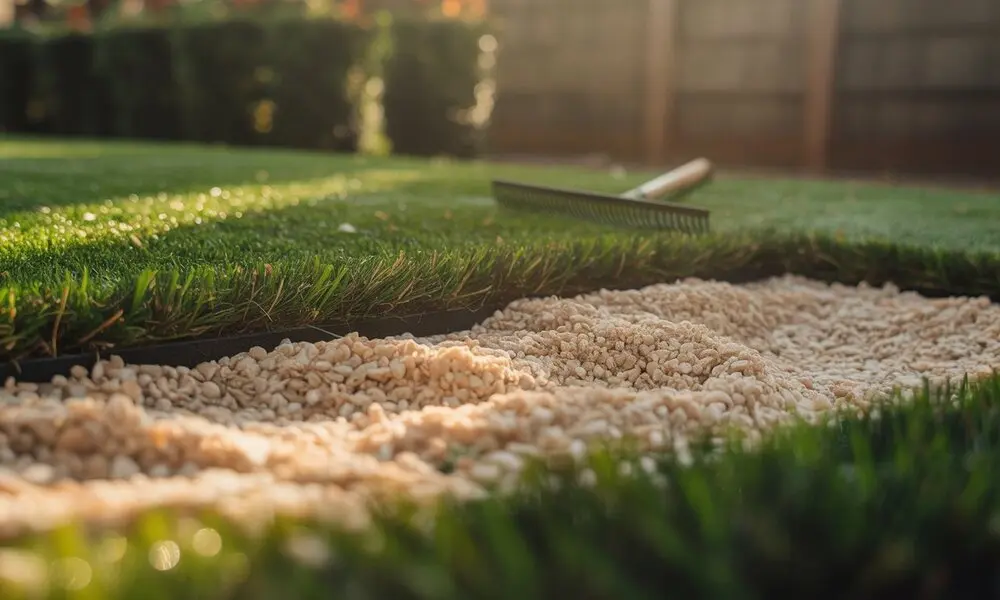
Choosing the best infill for artificial turf depends on how the turf will be used. Different infill materials provide unique benefits for durability, safety, odor control, and sustainability. By comparing options, you can select the synthetic turf infill that best matches your needs whether it’s for a backyard, sports field, or pet-friendly lawn.
Factors to consider
When selecting infill for turf, consider:
- Purpose: The purpose could be for homes, pets, kids’ play spaces, sports, or business.
- Durability: how well it withstands heavy use
- Safety: cushioning and shock absorption
- Maintenance: odor control, cleaning, and drainage
- Eco-friendliness: sustainable and non-toxic options
Comparison of turf infill options
Infill Type | Cost | Durability | Safety | Maintenance | Eco-Friendly |
Silica Sand | Low | Moderate | Moderate | Low upkeep | Neutral |
Crumb Rubber | Moderate | High | High (cushion) | Moderate | Low |
Zeolite | Moderate | Moderate | Good | Excellent (odor control) | Neutral |
Durafill (Coated Sand) | Higher | High | Safe/Non-toxic | Low upkeep | Neutral |
Organic (Cork, Walnut) | Higher | Moderate | Good | Moderate | High |
Recommendations
- For pets → use Zeolite or Durafill because they are safe and keep smells away.
- For kids and play areas → A rubber + sand mix for extra cushioning and fall protection
- For sports grounds → rubber infill is the greatest choice because it absorbs shock and lasts the longest.
- For homeowners who care about the environment → Use organic materials like cork or walnut shells for a long-lasting fix.
If you want professional turf installation service in San Jose or nearby areas, contact Lakota Design Group. Our experts provide high-quality artificial turf solutions that enhance your outdoor space with durability, beauty, and low maintenance. Reach out today to transform your landscape!
How Much Infill Do I Need For Artificial Turf?
The amount of infill for turf depends on the type of application and the height of the synthetic grass blades. In general, synthetic turf infill is measured in pounds per square foot, with the goal of keeping blades upright, improving stability, and ensuring long-lasting performance.
General rule of thumb
Most installations require 1 to 3 pounds of infill per square foot. Shorter turf pile heights may need less, while taller, thicker turf blades need more infill to maintain support and prevent flattening.
Variables that affect infill amount
- Turf pile height – Taller turf requires more infill for support
- Foot traffic – High-traffic areas (sports fields, playgrounds) need extra infill for durability
- Application type – Residential lawns often use less than commercial or athletic installations
Example calculation
For a standard residential lawn with 1,000 sq. ft. of turf and an average pile height of 1.5 inches:
- Using 2 lbs of infill per sq. ft. → 1,000 x 2 = 2,000 lbs of infill needed
This ensures the lawn stays stable, natural-looking, and long-lasting.
Conclusion
Infill is essential for artificial turf, adding support, cushioning, and proper drainage. It helps turf blades stay upright, look natural, and last longer. The right synthetic turf infill depends on your purpose residential, pets, kids, or sports. Silica sand, rubber, zeolite, Durafill, and organic options all offer unique advantages.
There is no single “best” infill it’s about choosing what fits your needs. Professional guidance ensures the turf performs at its best. At Lakota Design Group, we provide expert advice and installation contact us today to transform your outdoor space!
FAQs
1. What Is The Best Infill For Artificial Turf In Residential Lawns?
For most residential applications, silica sand or Durafill are popular because they provide stability, keep blades upright, and require little maintenance.
2. Which Infill Is Best For Pets?
Zeolite is one of the best choices for pet-friendly turf since it controls odors naturally. Durafill is another safe option because it’s non-absorbent and easy to clean.
3. What Infill Works Best For Kids’ Play Areas?
A rubber and sand mix is recommended for playgrounds since it adds extra cushioning, shock absorption, and safety for children.
4. What Type Of Infill Is Used For Sports Fields?
Crumb rubber is commonly used for athletic fields due to its durability and high shock absorption, making it ideal for heavy use.
5. Is Organic Infill A Good Option?
Yes, organic infill materials like cork, walnut shells, or coconut fibers are eco-friendly and provide a cooler, natural feel, making them perfect for environmentally conscious homeowners.

